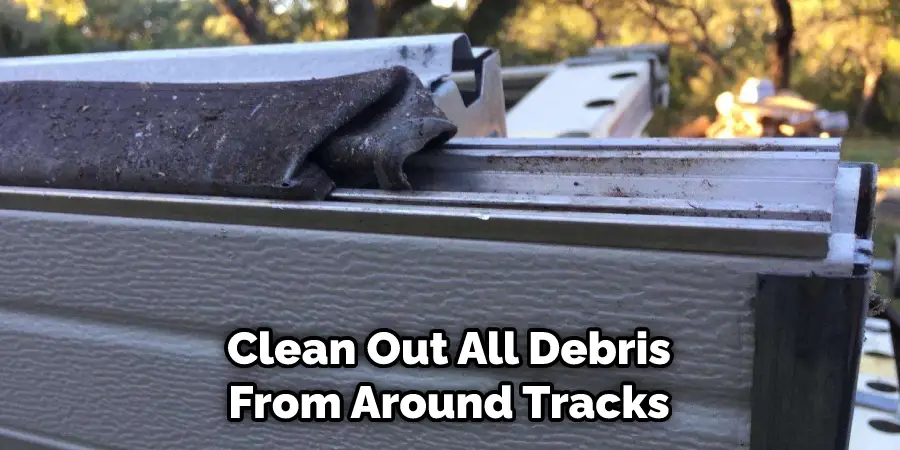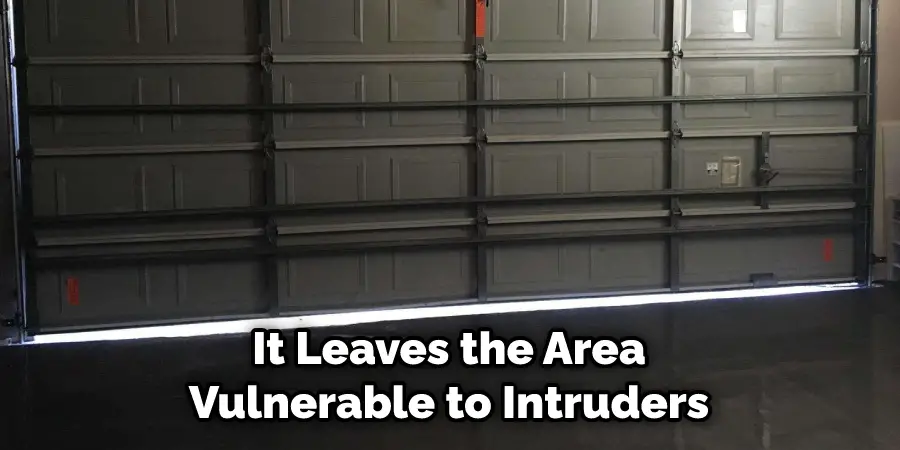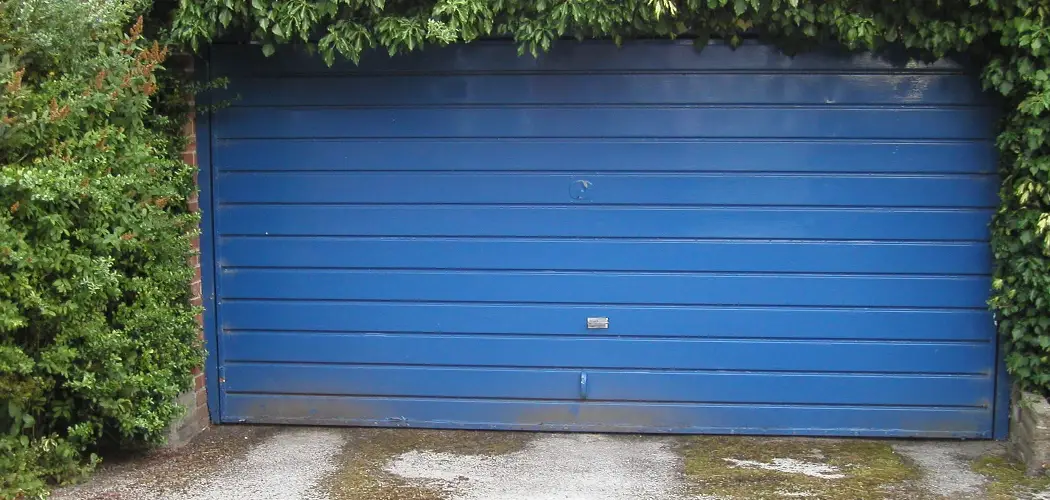Are you noticing a gap at the bottom of your garage door? This can be an eyesore and indicate that you are in need of some minor repair work.
If you’re like most homeowners, dealing with a gap at the bottom of your garage door can be an eyesore. That pesky little gap makes your house look incomplete and gives room for pests to enter.

Not only that, but severe weather conditions can also infiltrate through it and cause damage to any items you may store inside the garage. Fortunately, there are several ways you can take measures to address this issue without having to hire someone for expensive repairs or replacements.
In this blog post, we’re going to provide some simple DIY tips on how to fix gap at bottom of garage door using various materials. Keep reading!
Summary: Garage doors are a great way to add security and convenience to your home, but they can come with some maintenance issues. One of the most common problems is a gap at the bottom of the door that allows air, dust, or even pests to come in. Fortunately, there are several ways to fix gap at bottom of garage door that can help you maintain a neat and tidy garage without compromising security or convenience.
What Will You Need?
Depending on the severity of the gap, you may need some basic tools and materials to fix it.
Tools
- Measuring tape
- Level
- Drill/screwdriver
- Utility knife/box cutter
Materials
- Weather-stripping (pre-cut if applicable)
- Self-adhesive foam tape
- Rope caulk
- • Caulking gun
Once you have all the necessary tools and materials on hand, you can begin fixing the gap at the bottom of the garage door.
13 Easy Steps on How to Fix Gap at Bottom of Garage Door
Step 1: Inspect the Gap and the Garage Door
Begin by inspecting the gap at the bottom of your garage door to determine its size and cause. Look for any signs of damage or wear on the door, the weatherstripping, or the garage door track. Identifying the source of the gap will help you determine the appropriate solution for fixing it.
Step 2: Check the Garage Door Alignment
A misaligned garage door can cause gaps at the bottom. Use a level to check the alignment of the door and the tracks. If the door or tracks are not level, adjust them by loosening the brackets holding the tracks in place, shifting them until they are level, and then tightening the brackets.
Step 3: Inspect the Weatherstripping
The weatherstripping at the bottom of the garage door helps to create a seal and prevent gaps. Inspect the weatherstripping for wear, damage, or improper installation. If the weatherstripping is damaged or worn, it will need to be replaced to effectively seal the gap.
Step 4: Replace the Weatherstripping
To replace the weatherstripping, remove the old weatherstripping by either unscrewing it or prying it off with a flat-head screwdriver. Clean the area where the old weatherstripping was attached, then measure and cut a new piece of weatherstripping to fit the width of your garage door. Attach the new weatherstripping by either screwing it in place or using an adhesive, following the manufacturer’s instructions.
Step 5: Adjust the Garage Door Limit Switch
If the garage door is not closing fully, leaving a gap at the bottom, the limit switch may need to be adjusted. The limit switch controls how far the door travels when closing. Locate the limit switch on the garage door opener motor unit and consult your garage door opener’s user manual for instructions on how to adjust it. Make small adjustments to the limit switch until the door closes fully and eliminates the gap.
Step 6: Inspect the Garage Door Rollers
Worn or damaged garage door rollers can cause the door to sit unevenly, resulting in a gap at the bottom. Inspect the rollers for signs of wear or damage and replace any that are not functioning properly. To replace a roller, remove the bolt and nut holding the roller in place, slide the old roller out of the bracket, and insert a new roller before reattaching the bolt and nut.
Step 7: Check the Garage Door Springs
The garage door springs provide tension that helps the door close evenly. If a spring is damaged or has lost tension, it can cause a gap at the bottom of the door. Inspect the garage door springs for signs of wear or damage. If a spring needs to be replaced, it is recommended to hire a professional garage door technician, as replacing garage door springs can be dangerous if not done correctly.
Step 8: Inspect and Adjust the Garage Door Track
A misaligned garage door track can cause the door to sit unevenly and create a gap at the bottom. Inspect the track for damage or misalignment, and adjust it as necessary. To adjust the track, loosen the bolts holding it in place, gently tap the track with a rubber mallet until it is properly aligned, and then tighten the bolts.
Step 9: Test the Garage Door
After making adjustments or repairs, test the garage door to ensure that it is closing fully and that the gap at the bottom has been eliminated. Operate the door using the wall-mounted button, remote control, or keypad and observe its movement to confirm that it is closing evenly and securely.
Step 10: Perform Regular Maintenance
To prevent future gaps at the bottom of your garage door, perform regular maintenance, including inspecting the door
, weatherstripping, tracks, rollers, springs, and other components for signs of wear or damage. Lubricate moving parts, such as rollers and hinges, with a high-quality garage door lubricant to ensure smooth operation and reduce wear. Maintain proper alignment of the door and tracks by periodically checking their level and making adjustments as needed.
Step 11: Insulate the Garage Door
If you live in a region with extreme temperature fluctuations, consider insulating your garage door to help maintain a consistent temperature inside the garage and reduce the likelihood of gaps forming at the bottom. Insulation kits are available for various garage door types and can be installed following the manufacturer’s instructions.
Step 12: Install a Garage Door Threshold
A garage door threshold is a rubber or vinyl strip that is installed on the garage floor where the door closes, creating a tight seal and preventing gaps at the bottom of the door. Measure the width of your garage door opening and purchase a threshold that is the appropriate length. To install the threshold, clean the garage floor, apply adhesive according to the manufacturer’s instructions, and press the threshold into place.
Step 13: Consult a Professional
If you have attempted to fix the gap at the bottom of your garage door and are still experiencing issues, consult a professional garage door technician for assistance. They can diagnose and resolve any problems, ensuring the safe and proper operation of your garage door system.
By following these steps, you can effectively fix the gap at the bottom of your garage door, ensuring a secure and well-sealed closure. Regular maintenance and inspections will help prevent future issues, while additional measures such as insulation and the installation of a garage door threshold can further improve the seal and performance of your garage door. If you encounter any persistent or complex issues, seek the help of a professional garage door technician to ensure the safety and functionality of your garage door system.
5 Additional Tips and Tricks
- Replace the weather seal or bottom rubber strip if it is worn out. This will usually fix small gaps at the bottom of your garage door.
- Check for any warping or bending of the door itself. This can cause a large gap at the bottom of your garage door if it is not level. Use a level to check how even the door is and adjust as needed.
- Make sure all screws on hinges and tracks are tightened securely. screws can cause gaps in the bottom of the garage door that may need to be adjusted or replaced with longer screws.
- Consider adding insulation around the edges of the opening if there is still a gap after tightening all screws and ensuring your door is level. This will help prevent drafts from entering through small openings in the bottom of your garage door.
- Clean out all debris from around tracks and hinges that may prevent the door from closing properly. This can help to eliminate gaps at the bottom of your garage door

Whatever the case, having a secure and properly working garage door is essential for keeping your home safe and secure. Make sure to take all necessary steps to ensure this!
5 Things You Should Avoid
- Don’t try to fix the gap yourself if you don’t have experience with a garage door repair. Doing it incorrectly can cause more damage and may even be dangerous for you or your family.
- Don’t use a gap sealant like a foam to fill the gap between your door and floor. This material isn’t designed to last long-term, so you’ll have to do the job again in no time.
- Don’t ignore how much pressure is on your door springs when adjusting how close the garage door sits against the floor. Too much tension could cause other problems and make it difficult for you to open and close the door safely.
- Don’t increase the tension of your springs too much, as this could cause them to break.
- Don’t forget to check for any other issues that need repair, including the gap at the bottom of your door, such as worn-out rollers or a damaged track.
Taking the time to repair the gap at the bottom of your garage door will ensure that you and your family are safe and keep heat and air from entering or escaping your home. With a few simple steps, you can close up any gaps and keep your garage door working like new.
Should There Be a Gap at the bottom of the Garage Door?
The answer to this question is no. It is important that the gap at the bottom of your garage door be as close to zero as possible. This will help protect your home from wind and rain, cold air drafts, pests, and debris.
Having a gap can also lead to safety issues since it leaves the area vulnerable to intruders—especially in older garages without secure locking mechanisms. Therefore, make sure to take any necessary steps to reduce or eliminate this gap for optimal security and protection.

If you have any queries, don’t hesitate to reach out for professional help! A qualified technician will be able to provide assistance with fixing the problem quickly and easily. With their help, you can be confident that your garage door is secure and properly functioning. Good luck, and have fun!
Conclusion
Now that you know how to fix gap at bottom of garage door, you no longer need to worry about whether or not you left the house without closing the garage. With just a few clicks on your phone, you can ensure that your belongings and loved ones are always safe and secure.
At the same time, this technology offers so much convenience as it allows you to access your most-needed storage areas whenever you need them. It’s great for busy lives, families on the go, or anyone who prioritizes added security and effortless opening. Make the digital switch today and thank yourself later for bringing a new level of convenience into your home!
Hopefully, this article has shed some light on fixing the gap at the bottom of your garage door. Make sure that you take all necessary steps to reduce or eliminate this gap so that your home is safe and secure. Thanks for reading!


